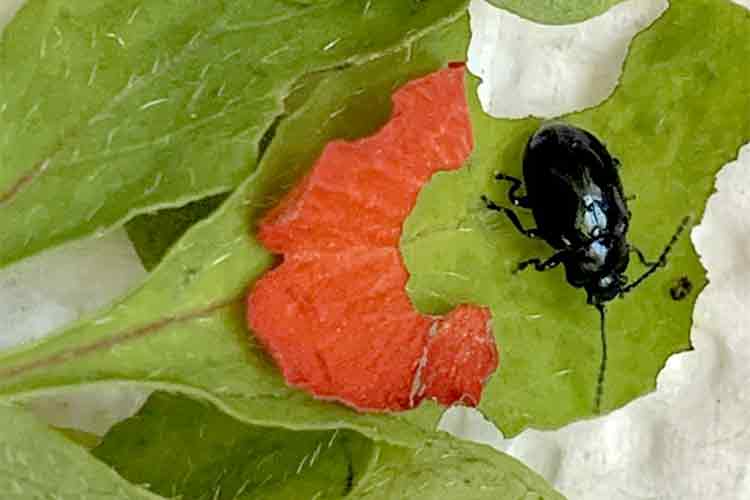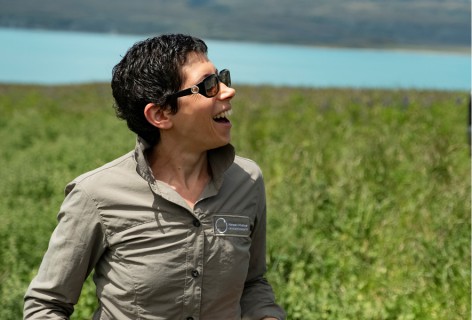Coming Soon! The Chilean Flame Creeper Beetle

Adult leaf beetle
As for the yellow flag iris project, teams in the North and South Islands embarked on surveys to look for herbivores and pathogens already attacking the plant here. Finding time to conduct the surveys between Covid-19 lockdowns and inter-island travel restrictions was no mean feat, but the teams managed to pull off the work in record time to complete the surveys. Although Chilean flame creeper is naturalised in parts of New Zealand from Stewart Island / Rakiura to Waikato, it is mainly a problem in Southland, where it suppresses and replaces native species through shading and its smothering growth. Currently only isolated populations are present in the North Island.
Ten sites were included in the surveys, half of which were visited in the autumn of 2021 and the other half in late summer of 2022. The autumn surveys were timed to optimise the detection of fungal pathogens, and the summer surveys to optimise detection of herbivores. “We found a variety of critters on Chilean flame creeper, but none could be considered as biocontrol agents,” said Chantal Probst, who led the North Island crew. Of the 56 species or taxonomic units of invertebrates that were collected, 23 are herbivorous and three are omnivorous. None are host specific, nor are they highly damaging to the plant. In addition, none were abundant, all being classified as either occasional (four species / taxonomic units), or rare (19 species / taxonomic units) on Chilean flame creeper in most instances. “We found no leaf-feeding beetles and, most importantly, we didn’t find the chrysomelid leaf beetle (Blaptea elquetai) that is our prospective agent for this weed,” added Robyn White, who led the South Island crew.
The team also looked for parasitoids and predators that could potentially derail biocontrol efforts. Although a few parasitoids were collected, none are parasitoids of beetles. The predators that were found are generalists, and there were only a few, which is not surprising given the low overall abundance of potential prey associated with the Chilean flame creeper plants that were sampled. Interestingly, three sites (all in the North Island) had no invertebrates at all on the Chilean flame creeper plants that were sampled!
In terms of fungal pathogens, there were hardly any disease symptoms on Chilean flame creeper plants. The few symptoms observed were leaf spots, leaf yellowing and leaf reddening. Leaves with symptoms were taken to the laboratory for culturing, which yielded 34 species in 18 genera. Nine species are known pathogens with a wide host range. Another 12 are known from a variety of hosts, and can be either pathogenic, endophytic or saprophytic, depending on the host. The remaining species are all either endophytes or saprophytes.
Once the survey data were analysed we were able to conclude that none of the organisms associated with Chilean flame creeper in New Zealand are sufficiently specific and/or damaging to be considered a potential agent, and that the risks of predators or parasitoids disrupting a biocontrol programme is small. “Consequently, we think it is wise to proceed researching the leaf beetle to determine its suitability as a biocontrol agent,” explained Chantal.
The leaf beetle in question was discovered serendipitously during surveys for a rust fungus that attacks Darwin’s barberry (Berberis darwinii) in Chile in late 2019. Our Chilean collaborator, Dr Hernán Norambuena, immediately started work on the beetle, which continued during this last summer season. Hernán’s first challenge was to find new collection sites for the beetle. Chilean flame creeper is rare in its native range, and habitat destruction has made it even scarcer. For example, some of the original sites where Hernán was initially able to collect beetles are now construction sites. “We were very relieved to hear that Hernán found new sites now that Covid-19 travel restrictions have lifted,” said Ronny Groenteman, who leads the project. Hernán travelled to places where the plant has previously been recorded. At some he hit gold, at others there was no sign of the plant, and fortunately, while on the road between historical Chilean flame creeper sites, he discovered 14 new sites. This made a total of 29 Chilean flame creeper sites for surveying, which is a substantial improvement on the two sites we had to rely on in the early days!
Egg-laying adults were found and collected from 20 of these sites. An important find this season was leaf beetle eggs in the field. Hernán was perplexed last year when he could not find where the beetles lay their eggs. “They happily oviposited on a piece of paper in the laboratory, but no eggs were to be seen in the field,” recalled Ronny. But this time, they were found on Chilean flame creeper leaves, on nearby vegetation, in the leaf litter, and even in the soil under the plants. Eggs were found in the field from late September to early December. Hernán also found larvae at 15 sites, and their developmental stage ranged from newly hatched to nearing pupation.
Some sites were visited twice through the season, which provided a better understanding of the beetles’ phenology at different latitudes. This allows us to plan the timing of collection for when we want to import these beetles into containment in New Zealand for host range testing.
Hernán’s next challenge was to learn more about the biology and life cycle of the beetle. He compared egg laying and larval development between beetle populations collected from low-altitude sites earlier in the season with those collected from higher-altitude sites later in the season. He concluded that eggs laid by early active adults from lower altitudes have higher viability. This, too, is very useful information for planning where and when to collect beetles for importing to New Zealand.
Another useful observation was that newly hatched larvae did not start feeding immediately. This may be an indication that the beetle larvae search for their host plant, and is an important observation for the testing environment we use to assess host specificity.
While surveying field sites Hernán was also on the lookout for any other promising natural enemies of Chilean flame creeper. Similar to the previous season, he found a few caterpillars of a plutellid moth, but they were again found in small numbers and, based on Hernán’s observations, do not inflict much damage to Chilean flame creeper. Hernán also noted that the moth was always found at sites adjacent to rapeseed (Brassica napus var. napus) fields, so it is likely that rapeseed is one of its main host plants. Armyworm larvae were found on Chilean flame creeper at a couple of sites, but these too appear to be a spillover from other vegetation growing in association with Chilean flame creeper. Further, Hernán’s attempts to rear these larvae on Chilean flame creeper foliage in the laboratory were unsuccessful. Finally, another leaf beetle was found when beating Chilean flame creeper plants, but it, too, seems to be associated with a native shrub that grows in association with Chilean flame creeper and does not feed on the creeper at all.
“Thus,” says Hernán, “our conclusion that the leaf beetle Blaptea elguetai is the key natural enemy of Chilean flame creeper, and should be pursued for biological control, remains unchanged.”
“As for other work,” said Ronny, “we continue to build up our stock of test plants, and all going according to plan with the borders opening, we hope to see these beetles in containment in New Zealand this coming spring for host specificity testing.”

